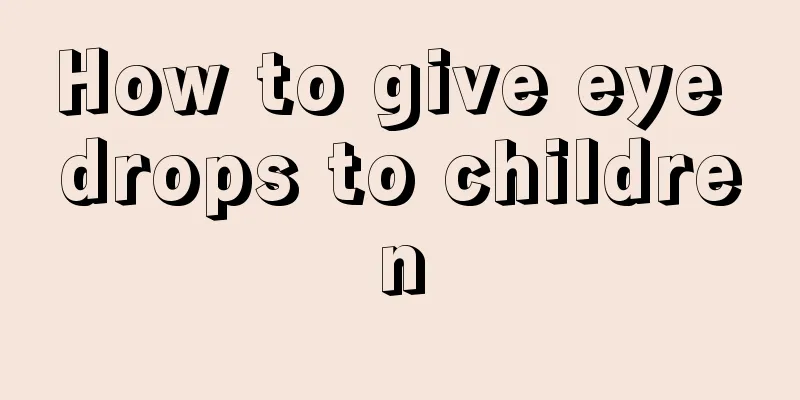How to give eye drops to children

|
Eye drops are a common medicine in life. Many children need eye drops because of eye problems. But how do you give eye drops to children? After all, many eye drops are irritating to the eyes, and the eyes are the most sensitive part of the body, so parents should be particularly careful when giving their children eye drops. Don’t think that it is easy to give children eye drops. Some children have conjunctivitis, and their parents say that they have been using eye drops for more than 10 days but there is no improvement, and they think these eye drops are ineffective. In fact, it’s not that eye drops are ineffective, but that the method and time of parents applying eye drops are inappropriate. Especially when giving eye drops to children, if the method of dropping the medicine is improper or the timing is not well controlled, it will not only affect the treatment effect, but may also cause other problems. If the medicine is applied properly, the child's eye disease will heal quickly. Children generally cannot put eye drops by themselves and need help from their parents. Therefore, parents should master the correct method of putting eye drops and precautions: (1) Time for eye drops in children Applying eye drops to children is different from that to adults. It is often difficult to apply the drops because of crying or non-cooperation. If the child cries after the drops are dropped into the eye, the tears will immediately wash the drops out. Not only will it fail to have the desired effect, but it will make the eyeball congestion (redness) even more serious. Therefore, for children who cannot cooperate, attention should be paid to the time of drug drops. Do not mechanically think that 3 drops a day are enough. The best time is in the morning, noon and evening when going to bed or before waking up. Applying eye drops before sleeping can ensure that the eye drops are dropped into the conjunctival sac and keep the eyes closed for a longer time. The effect is indeed reliable. For more severe conjunctivitis (such as pink eye), add a few drops during the day or at night. (2) How to give eye drops to children Even if the medicine is not dripped properly when the child is sleeping, it may wake the child up, causing crying and affecting treatment. The correct way is to use the thumb and index finger of the left hand to gently pull open the lower eyelid after the child falls asleep, expose the lower eyelid conjunctiva or lower fornix, then put 1 to 2 drops of eye drops into the conjunctival sac of the lower fornix, and then gently relax the lower eyelid to restore the closed eye state. This generally will not wake the child up. Never drop eye drops on the black pupil (on the cornea) because the nerves in the black pupil are widely distributed and are very sensitive to external stimuli. Dropping eye drops in will easily wake the child up. In addition, when putting medicine in your eyes, do not place the dropper too close to the eyelid (generally 1 to 2 cm away from the eyelid edge), and do not let the dropper touch the eyelashes or eyelids to avoid contamination of the eye drops or injuring the eyes when the child moves his head. (3) Precautions when giving medicine drops to children ① Wash your hands before applying the medicine and prepare the eye drops. ② Pay attention to the drug name and concentration, shake it to see if there is any sediment, flocs, or discoloration. Eye drops that have changed color or have sediment should not be used. ③ Pay attention to the production date or expiration date on the eye drops bottle. If the eye drops are ineffective or expired, it means that the eye drops have deteriorated. Using such eye drops will not only fail to cure the eye disease, but will worsen the eye disease or bring new problems. ④ If both eyes are diseased, or one eye is diseased and the other eye needs preventive drops (such as acute conjunctivitis in one eye), when both eyes need eye drops, the eye with the less severe disease or the one that needs preventive drops should be given first, and then the diseased or seriously ill eye. ⑤ When you need to put several eye drops at the same time, you can put one eye drop first, and then put another eye drop after 20 to 30 minutes. ⑧Close your eyes for 2 to 3 minutes after applying eye drops. After the eye drops are dripped into the conjunctival sac, the concentration of the eye drops will be reduced by half after 3 minutes due to the dilution of tears. If the eyes are not closed after the drops are dripped, the drops can only remain in the conjunctival sac for a maximum of 20 seconds. In this way, even if the drops are dripped 4 to 6 times a day, the efficacy can only last for 120 seconds, and the therapeutic effect is poor. If the child can close his eyes for 2 to 3 minutes after the medicine is applied, the excretion of the medicine will be slowed down and the absorption of the medicine will be increased, and the effectiveness of the eye drops will be improved. In addition, some eye drops are suspensions, such as 0.5% cortisone acetate eye drops. When left standing, the medicine and water separate and the liquid medicine settles at the bottom of the bottle. Before dropping the medicine, you need to shake the liquid medicine thoroughly to make it milky and then drop it. The particles in this eye drops are absorbed slowly. You need to close your eyes for 3 to 5 minutes after applying the medicine to allow it to be fully absorbed and achieve better results. To sum up, when giving eye drops to children, you should avoid letting them move around. At the same time, giving children eye drops is also the most commonly used method of treating pediatric eye diseases in the hospital's ophthalmology department. Some common eye diseases in children include conjunctivitis, keratitis, allergic conjunctivitis, trachoma, etc. Parents can also consult a doctor before giving their children eye drops. |
<<: Can children use eye drops?
>>: Parent-child warm-up exercise
Recommend
Can children eat aloe vera mineral crystals?
Aloe vera mineral crystal is a relatively common ...
What is the best way to treat cerebral palsy?
I believe everyone must be familiar with diseases...
How to deal with children's vulva itching
We all know that women are more susceptible to ce...
What can children eat to reduce internal heat?
Whether adults or children, they are prone to the...
What to do if your newborn baby spits bubbles
The bodies of newborns are relatively fragile. Af...
Three month old baby always bites his lips
Many parents are very distressed that their three...
What to do if a child has a fever in autumn
Everyone knows that the temperature in autumn is ...
What should I do if my child has a blocked nose when sleeping?
Children's sleep is a very important part, wh...
At what age is it best to treat phimosis in babies?
If a young child has phimosis, parents must pay a...
My baby’s body temperature is normal but his hands and feet are hot. Why?
It is almost September now and the beginning of a...
Introduction to protruding belly button of 2-month-old baby
We all know that the belly button is the scar lef...
Can newborns wear onesies?
In life, many babies wear onesies, because they l...
How to repair children's scars
Children’s liveliness and cuteness make everyone ...
How to prevent neonatal hemolysis
Many genetic diseases can occur in newborns, and ...
What should be the water temperature for a baby's bath?
Ordinary people may not have too many requirement...









